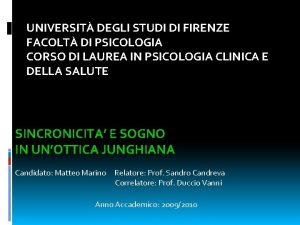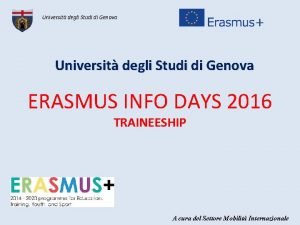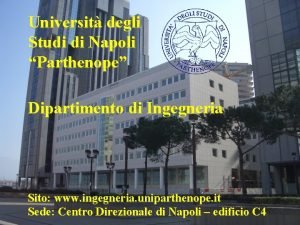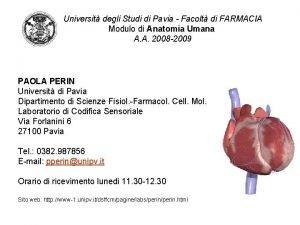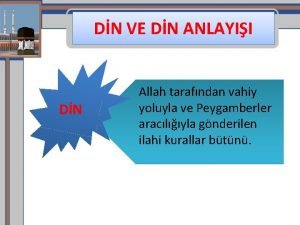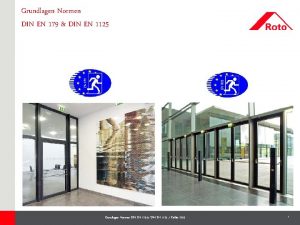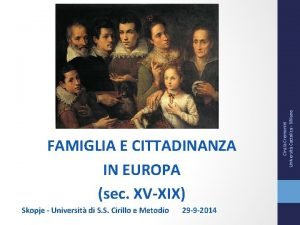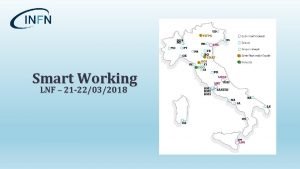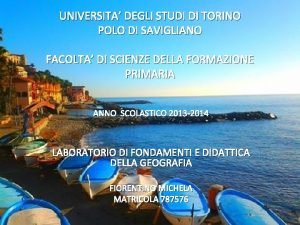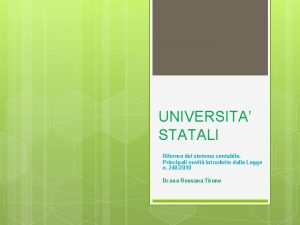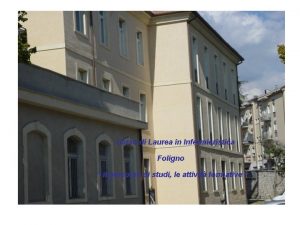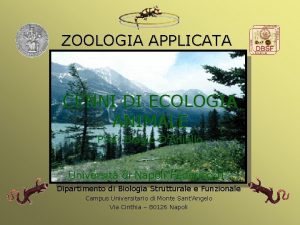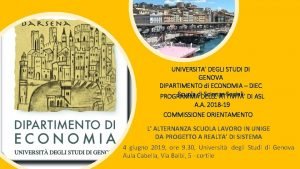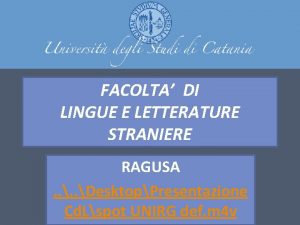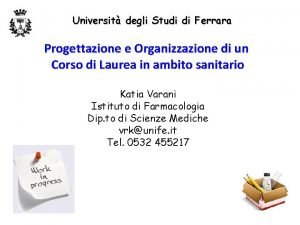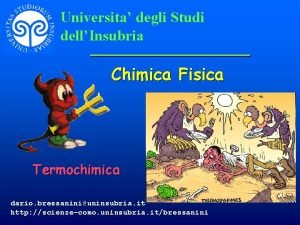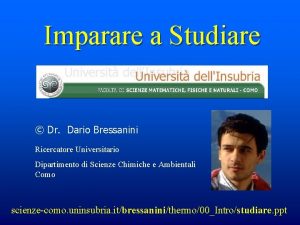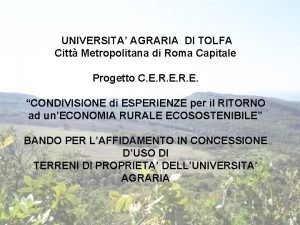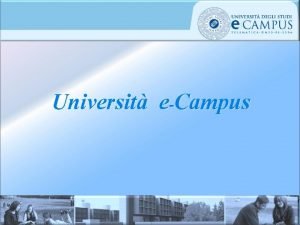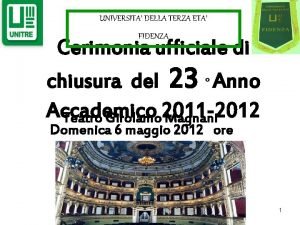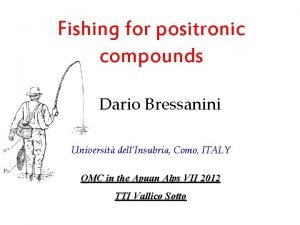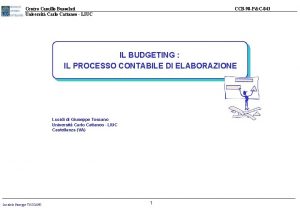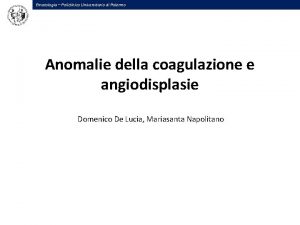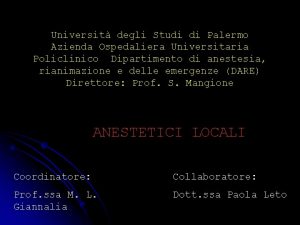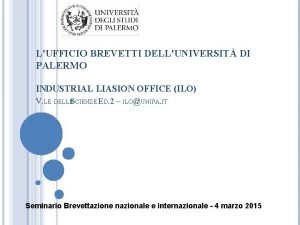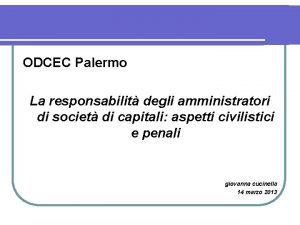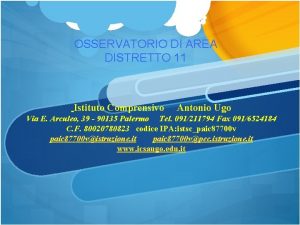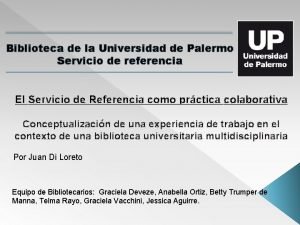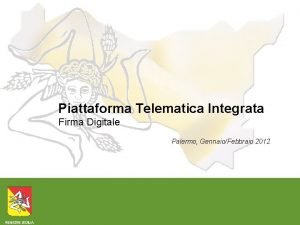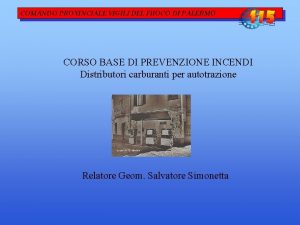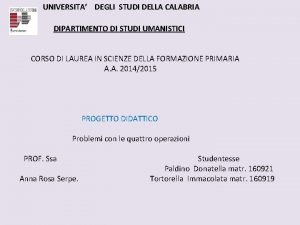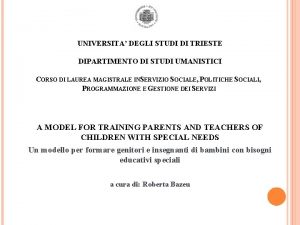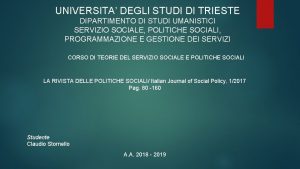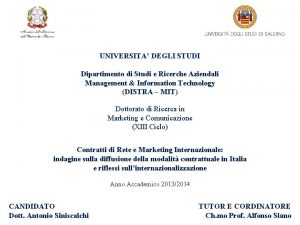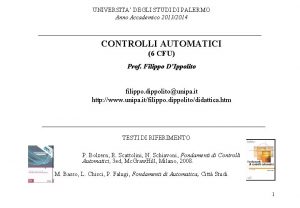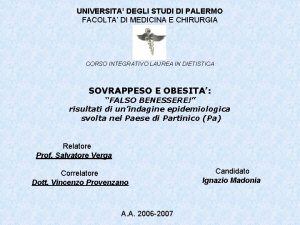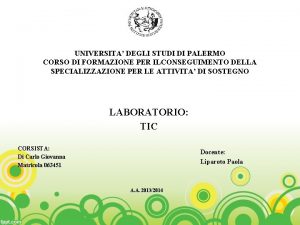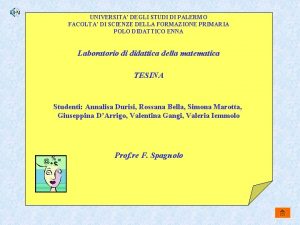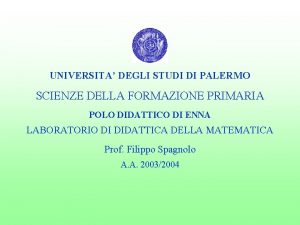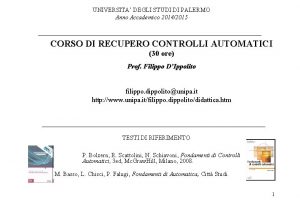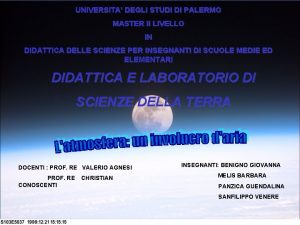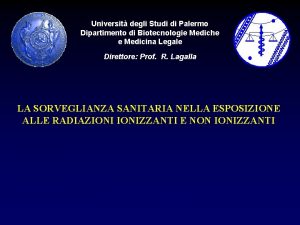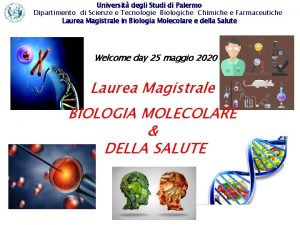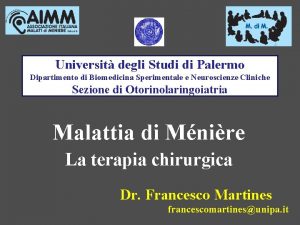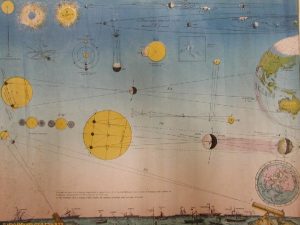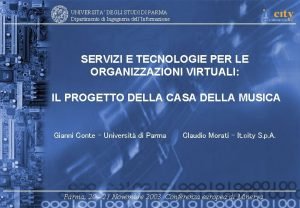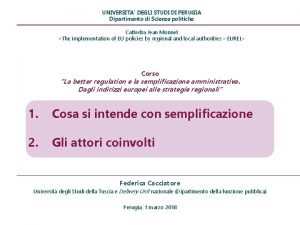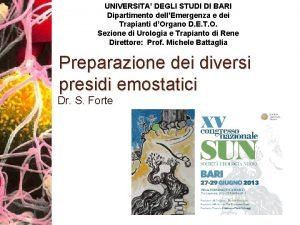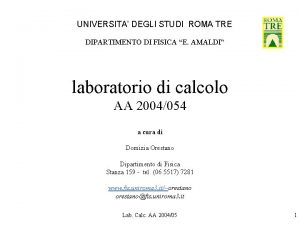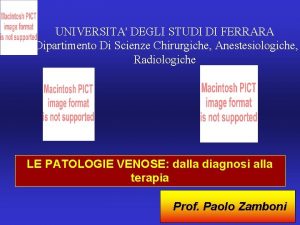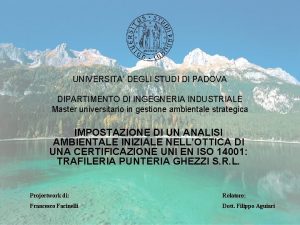UNIVERSITA DEGLI STUDI DI PALERMO DIN DIPARTIMENTO DI


































- Slides: 34

UNIVERSITA’ DEGLI STUDI DI PALERMO DIN DIPARTIMENTO DI INGEGNERIA NUCLEARE Design and realization of a radon chamber as a secondary standard A. Compagno, A. Parlato, S. Rizzo, E. Tomarchio Nuclear Engineering Department, Palermo University Viale delle Scienze , Ed. 6, I-90128 Palermo, ITALY Coimbra (Portugal), June 7, 2010 CHERNE 2010 - 6 th Workshop on European Collaboration for Higher Education and Research in Nuclear Engineering and Radiological Protection - 7 -9 June 2010 – University of Coimbra – Coimbra, Portugal

UNIVERSITA’ DEGLI STUDI DI PALERMO DIN DIPARTIMENTO DI INGEGNERIA NUCLEARE Introduction Radon gas is an environmental source of contamination, present in human living environments, with problems for human health. Radon is considered the second leading cause of lung cancer after smoking tobacco. Many homes (or workplaces) contain radon concentrations that are high enough to give their occupants lifetime exposures that could increase their risk of developing lung cancer. CHERNE 2010 - 6 th Workshop on European Collaboration for Higher Education and Research in Nuclear Engineering and Radiological Protection - 7 -9 June 2010 – University of Coimbra – Coimbra, Portugal

UNIVERSITA’ DEGLI STUDI DI PALERMO DIN DIPARTIMENTO DI INGEGNERIA NUCLEARE Introduction It should be stressed that the current actions to mitigate the radon concentration indoors (typically local ventilation) are in contrast with the actions for energy saving in buildings. Hence the need to characterize building materials in terms of an emanation/permeation to radon, selecting those that represent the best barriers for this gas. CHERNE 2010 - 6 th Workshop on European Collaboration for Higher Education and Research in Nuclear Engineering and Radiological Protection - 7 -9 June 2010 – University of Coimbra – Coimbra, Portugal

UNIVERSITA’ DEGLI STUDI DI PALERMO DIN DIPARTIMENTO DI INGEGNERIA NUCLEARE Introduction Radioactive series Radon is a radioactive noble gas that comes from the decay of radium in the soil. Radium is also a daughter or progeny nuclide of uranium. Radon is a colorless, odorless, invisible gas that can only be detected through the use of proper equipment and protocols. CHERNE 2010 - 6 th Workshop on European Collaboration for Higher Education and Research in Nuclear Engineering and Radiological Protection - 7 -9 June 2010 – University of Coimbra – Coimbra, Portugal

UNIVERSITA’ DEGLI STUDI DI PALERMO DIN DIPARTIMENTO DI INGEGNERIA NUCLEARE Introduction The air concentration of radon should be limited also in consideration of recent indications regarding a limit of 100 Bq m-3 and an increase of conversion ratio between air concentration and effective dose : C= 300 Bq m-3 correspond to E=10 m. Sv y-1 ”WHO Handbook on Indoor Radon: A Public Health Perspective” The actual regulation limits are : National Laws: < 500 Bq/m 3 (workplaces); 90/143/Euratom: Old building concentration < 400 Bq/m 3 New building < 200 Bq/m 3 CHERNE 2010 - 6 th Workshop on European Collaboration for Higher Education and Research in Nuclear Engineering and Radiological Protection - 7 -9 June 2010 – University of Coimbra – Coimbra, Portugal

UNIVERSITA’ DEGLI STUDI DI PALERMO DIN DIPARTIMENTO DI INGEGNERIA NUCLEARE Introduction To measure the concentration of radon gas in indoor environments (homes or workplaces) we need tools calibrated with reference to a primary standard. Since it is not easy to have a primary standard, is a useful a secondary standard in which radon concentration is measured by an instrument whose calibration is performed at a primary standard center. CHERNE 2010 - 6 th Workshop on European Collaboration for Higher Education and Research in Nuclear Engineering and Radiological Protection - 7 -9 June 2010 – University of Coimbra – Coimbra, Portugal

UNIVERSITA’ DEGLI STUDI DI PALERMO DIN DIPARTIMENTO DI INGEGNERIA NUCLEARE Introduction In this work we describe the design and the realization of a radon chamber to perform calibration of radon (or radon daughters) detectors. Other goals is : Ø Research about the influence of the environmental parameters on the detectors like temperature, pressure, humidity; Ø Measurement of gas emanation rate from varios materials (soils, building materials, …) CHERNE 2010 - 6 th Workshop on European Collaboration for Higher Education and Research in Nuclear Engineering and Radiological Protection - 7 -9 June 2010 – University of Coimbra – Coimbra, Portugal

UNIVERSITA’ DEGLI STUDI DI PALERMO DIN DIPARTIMENTO DI INGEGNERIA NUCLEARE Characteristics: ØVolume: Most chambers have volume <1 m 3, CHERNE 2010 - 6 th Workshop on European Collaboration for Higher Education and Research in Nuclear Engineering and Radiological Protection - 7 -9 June 2010 – University of Coimbra – Coimbra, Portugal

UNIVERSITA’ DEGLI STUDI DI PALERMO DIN DIPARTIMENTO DI INGEGNERIA NUCLEARE Characteristics: ØLarge volume ; few chambers have been built with large volumes (one or more rooms) also to calibrate the activated carbon canisters. ØMaterial not permeable to the Radon; Stainless steel is preferable with respect to more common plexiglas; Ø Airtightness; CHERNE 2010 - 6 th Workshop on European Collaboration for Higher Education and Research in Nuclear Engineering and Radiological Protection - 7 -9 June 2010 – University of Coimbra – Coimbra, Portugal

UNIVERSITA’ DEGLI STUDI DI PALERMO DIN DIPARTIMENTO DI INGEGNERIA NUCLEARE Characteristics: ØUniformity of radon concentration; Also with more instruments to be calibrated inside ØStability of environmental parameters To test instruments with different climate conditions in the range : • temperature range: -10°C +50°C • pressure range : 600 - 1200 mbar • humidity range : 5 - 95% Ø Easy decontamination; CHERNE 2010 - 6 th Workshop on European Collaboration for Higher Education and Research in Nuclear Engineering and Radiological Protection - 7 -9 June 2010 – University of Coimbra – Coimbra, Portugal

UNIVERSITA’ DEGLI STUDI DI PALERMO DIN DIPARTIMENTO DI INGEGNERIA NUCLEARE External source: (short-term calibration) Ø source: Ra-226 activity (8000 Bq) Ø volume of chamber : 400 l Ø concentration : 20. 000 Bq/m 3 CHERNE 2010 - 6 th Workshop on European Collaboration for Higher Education and Research in Nuclear Engineering and Radiological Protection - 7 -9 June 2010 – University of Coimbra – Coimbra, Portugal

UNIVERSITA’ DEGLI STUDI DI PALERMO DIN DIPARTIMENTO DI INGEGNERIA NUCLEARE External source To be acquired: 226 Ra solid source (activity: 8000 Bq) furnished by Pylon CHERNE 2010 - 6 th Workshop on European Collaboration for Higher Education and Research in Nuclear Engineering and Radiological Protection - 7 -9 June 2010 – University of Coimbra – Coimbra, Portugal

UNIVERSITA’ DEGLI STUDI DI PALERMO DIN DIPARTIMENTO DI INGEGNERIA NUCLEARE Design specification of the chamber: §Air volume : 0. 4 m 3 §Cylinder shape (to avoid uneven distribution of gas inside) §stainless steel (i. e. AISI 304) §two lids of 60 cm diameter and 8 bolts that secure the lids on the chamber at a sealing O-RING §Dimensions: 60 cm in diameter, 129. 5 cm in lenght §thickness : 4 mm §perforated aluminum platforms (supported by small cylindrical supports, to improve gas recirculation) § hermetic electrical connectors to transmit data between internal instruments and external computer (USB) § Swagelok quick-connects to minimizes spillage and air CHERNE 2010 - inclusion. 6 th Workshop on European Collaboration for Higher Education and Research in Nuclear Engineering and Radiological Protection - 7 -9 June 2010 – University of Coimbra – Coimbra, Portugal

UNIVERSITA’ DEGLI STUDI DI PALERMO DIN DIPARTIMENTO DI INGEGNERIA NUCLEARE Design specification of the chamber SPECIAL VALVE SPECIAL CONNECTOR With this connector it is possible to provide electronic signals inside and outside the chamber without escape of radon gas CHERNE 2010 - 6 th Workshop on European Collaboration for Higher Education and Research in Nuclear Engineering and Radiological Protection - 7 -9 June 2010 – University of Coimbra – Coimbra, Portugal

DIN UNIVERSITA’ DEGLI STUDI DI PALERMO DIPARTIMENTO DI INGEGNERIA NUCLEARE Design specification of the chamber The special valves and data transmission allows us to put inside the chamber also the circulating pump. This avoids possible leakage of radon gas because of no-sealing of the pump. chamber NO chamber p=pump s=source YES CHERNE 2010 - 6 th Workshop on European Collaboration for Higher Education and Research in Nuclear Engineering and Radiological Protection - 7 -9 June 2010 – University of Coimbra – Coimbra, Portugal

UNIVERSITA’ DEGLI STUDI DI PALERMO DIN DIPARTIMENTO DI INGEGNERIA NUCLEARE Design specification of the chamber: temperature control Temperature control is achieved by means of a circulation of water at controlled temperature in a copper pipe of 1 cm outer diameter and 0. 1 cm thick wrapped around the chamber with a helical pitch 5 cm. It will all be covered with appropriate insulating material. CHERNE 2010 - 6 th Workshop on European Collaboration for Higher Education and Research in Nuclear Engineering and Radiological Protection - 7 -9 June 2010 – University of Coimbra – Coimbra, Portugal

UNIVERSITA’ DEGLI STUDI DI PALERMO DIN DIPARTIMENTO DI INGEGNERIA NUCLEARE CHERNE 2010 - 6 th Workshop on European Collaboration for Higher Education and Research in Nuclear Engineering and Radiological Protection - 7 -9 June 2010 – University of Coimbra – Coimbra, Portugal

UNIVERSITA’ DEGLI STUDI DI PALERMO DIN DIPARTIMENTO DI INGEGNERIA NUCLEARE Radon chamber CHERNE 2010 - 6 th Workshop on European Collaboration for Higher Education and Research in Nuclear Engineering and Radiological Protection - 7 -9 June 2010 – University of Coimbra – Coimbra, Portugal

UNIVERSITA’ DEGLI STUDI DI PALERMO DIN DIPARTIMENTO DI INGEGNERIA NUCLEARE Radon chamber (FRONT) CHERNE 2010 - 6 th Workshop on European Collaboration for Higher Education and Research in Nuclear Engineering and Radiological Protection - 7 -9 June 2010 – University of Coimbra – Coimbra, Portugal

UNIVERSITA’ DEGLI STUDI DI PALERMO DIN DIPARTIMENTO DI INGEGNERIA NUCLEARE Radon Chamber (inside) CHERNE 2010 - 6 th Workshop on European Collaboration for Higher Education and Research in Nuclear Engineering and Radiological Protection - 7 -9 June 2010 – University of Coimbra – Coimbra, Portugal

UNIVERSITA’ DEGLI STUDI DI PALERMO DIN DIPARTIMENTO DI INGEGNERIA NUCLEARE Radon chamber (during preliminary tests) CHERNE 2010 - 6 th Workshop on European Collaboration for Higher Education and Research in Nuclear Engineering and Radiological Protection - 7 -9 June 2010 – University of Coimbra – Coimbra, Portugal

UNIVERSITA’ DEGLI STUDI DI PALERMO DIN DIPARTIMENTO DI INGEGNERIA NUCLEARE Radon chamber CHERNE 2010 - 6 th Workshop on European Collaboration for Higher Education and Research in Nuclear Engineering and Radiological Protection - 7 -9 June 2010 – University of Coimbra – Coimbra, Portugal

DIN UNIVERSITA’ DEGLI STUDI DI PALERMO DIPARTIMENTO DI INGEGNERIA NUCLEARE Detectors Alpha. Guard LR 115 MR 1 E-PERMs Rad 7 CR 39 CHERNE 2010 - 6 th Workshop on European Collaboration for Higher Education and Research in Nuclear Engineering and Radiological Protection - 7 -9 June 2010 – University of Coimbra – Coimbra, Portugal

UNIVERSITA’ DEGLI STUDI DI PALERMO DIN DIPARTIMENTO DI INGEGNERIA NUCLEARE Circuit of air conditioning: De-humidification CHERNE 2010 - 6 th Workshop on European Collaboration for Higher Education and Research in Nuclear Engineering and Radiological Protection - 7 -9 June 2010 – University of Coimbra – Coimbra, Portugal

UNIVERSITA’ DEGLI STUDI DI PALERMO DIN DIPARTIMENTO DI INGEGNERIA NUCLEARE Circuit of air conditioning : humidification CHERNE 2010 - 6 th Workshop on European Collaboration for Higher Education and Research in Nuclear Engineering and Radiological Protection - 7 -9 June 2010 – University of Coimbra – Coimbra, Portugal

UNIVERSITA’ DEGLI STUDI DI PALERMO DIN DIPARTIMENTO DI INGEGNERIA NUCLEARE Circuit of air conditioning : de-pressurization CHERNE 2010 - 6 th Workshop on European Collaboration for Higher Education and Research in Nuclear Engineering and Radiological Protection - 7 -9 June 2010 – University of Coimbra – Coimbra, Portugal

UNIVERSITA’ DEGLI STUDI DI PALERMO DIN DIPARTIMENTO DI INGEGNERIA NUCLEARE Circuit of air conditioning : pressurization CHERNE 2010 - 6 th Workshop on European Collaboration for Higher Education and Research in Nuclear Engineering and Radiological Protection - 7 -9 June 2010 – University of Coimbra – Coimbra, Portugal

UNIVERSITA’ DEGLI STUDI DI PALERMO DIN DIPARTIMENTO DI INGEGNERIA NUCLEARE Circuit of air conditioning : recycle CHERNE 2010 - 6 th Workshop on European Collaboration for Higher Education and Research in Nuclear Engineering and Radiological Protection - 7 -9 June 2010 – University of Coimbra – Coimbra, Portugal

UNIVERSITA’ DEGLI STUDI DI PALERMO DIN DIPARTIMENTO DI INGEGNERIA NUCLEARE Circuit of air conditioning : washing by pass CHERNE 2010 - 6 th Workshop on European Collaboration for Higher Education and Research in Nuclear Engineering and Radiological Protection - 7 -9 June 2010 – University of Coimbra – Coimbra, Portugal

UNIVERSITA’ DEGLI STUDI DI PALERMO DIN DIPARTIMENTO DI INGEGNERIA NUCLEARE low pressure over time preliminary tests CHERNE 2010 - 6 th Workshop on European Collaboration for Higher Education and Research in Nuclear Engineering and Radiological Protection - 7 -9 June 2010 – University of Coimbra – Coimbra, Portugal

UNIVERSITA’ DEGLI STUDI DI PALERMO DIN DIPARTIMENTO DI INGEGNERIA NUCLEARE high pressure over time preliminary tests CHERNE 2010 - 6 th Workshop on European Collaboration for Higher Education and Research in Nuclear Engineering and Radiological Protection - 7 -9 June 2010 – University of Coimbra – Coimbra, Portugal

DIN UNIVERSITA’ DEGLI STUDI DI PALERMO DIPARTIMENTO DI INGEGNERIA NUCLEARE Response variation with pressure: Tests performed at ENEA by one of the authors and verified with the new chamber Pressure (mbar) 1000 MR 1 Factor 1 ALPHAGUARD Factor 1 975 1 1. 024 950 0. 978 1. 038 890 0. 964 1. 096 CHERNE 2010 - 6 th Workshop on European Collaboration for Higher Education and Research in Nuclear Engineering and Radiological Protection - 7 -9 June 2010 – University of Coimbra – Coimbra, Portugal

UNIVERSITA’ DEGLI STUDI DI PALERMO DIN DIPARTIMENTO DI INGEGNERIA NUCLEARE In progress At this moment, further experiments are carried out: ØUniformity of radon concentration, by means of an external radon gas source and a circulating circuit with an external pump and E-PERM detectors; Ø Calibration of climate condition regulation apparatus ; ØEmanation rate of lava rocks coming from different sites; Ø……………. . CHERNE 2010 - 6 th Workshop on European Collaboration for Higher Education and Research in Nuclear Engineering and Radiological Protection - 7 -9 June 2010 – University of Coimbra – Coimbra, Portugal

UNIVERSITA’ DEGLI STUDI DI PALERMO DIN DIPARTIMENTO DI INGEGNERIA NUCLEARE Obrigado pela atenção Thank you for attention Coimbra (Portugal), June 7, 2010 CHERNE 2010 - 6 th Workshop on European Collaboration for Higher Education and Research in Nuclear Engineering and Radiological Protection - 7 -9 June 2010 – University of Coimbra – Coimbra, Portugal
 Università degli studi di firenze psicologia
Università degli studi di firenze psicologia Università degli studi roma tre mascotte
Università degli studi roma tre mascotte Kit dello studente erasmus unige
Kit dello studente erasmus unige Università degli studi di napoli
Università degli studi di napoli Unipv farmacia kiro
Unipv farmacia kiro Din ve din anlayışı arasındaki farklar
Din ve din anlayışı arasındaki farklar En 179
En 179 Università san cirillo e metodio skopje
Università san cirillo e metodio skopje Università firenze
Università firenze Polo di savigliano
Polo di savigliano Il nuovo sistema contabile e di bilancio delle università
Il nuovo sistema contabile e di bilancio delle università Scienze infermieristiche foligno
Scienze infermieristiche foligno Zoologia università napoli
Zoologia università napoli Universita economia genova
Universita economia genova Università di lingue ragusa
Università di lingue ragusa Mydesk unife docenti
Mydesk unife docenti Dario bressanini università
Dario bressanini università Dario bressanini università
Dario bressanini università Agraria tolfa
Agraria tolfa Università scienze motorie pisa
Università scienze motorie pisa Ecampus perugia
Ecampus perugia Università della terza età fidenza
Università della terza età fidenza Dario bressanini università
Dario bressanini università Università liuc costi
Università liuc costi Ematologia policlinico palermo
Ematologia policlinico palermo Aminoesteri
Aminoesteri Ufficio brevetti palermo
Ufficio brevetti palermo Odcec palermo
Odcec palermo Eiam palermo
Eiam palermo Piano strategico palermo
Piano strategico palermo Biblioteca universidad de palermo
Biblioteca universidad de palermo Firma digitale palermo
Firma digitale palermo Olsen palermo
Olsen palermo Prescrizioni normative sistemi controllo fumo
Prescrizioni normative sistemi controllo fumo Liceo danilo dolci orario scolastico
Liceo danilo dolci orario scolastico
